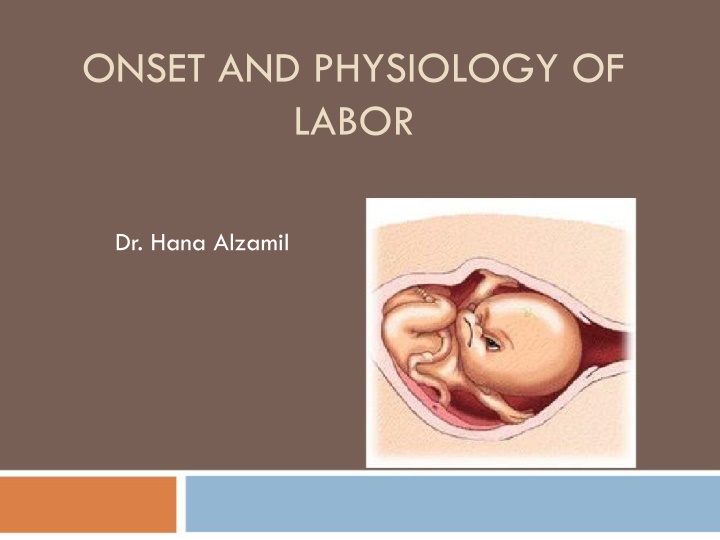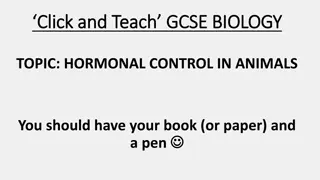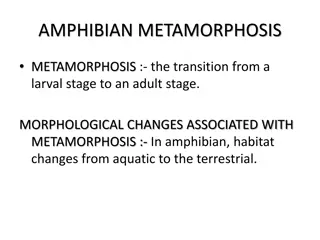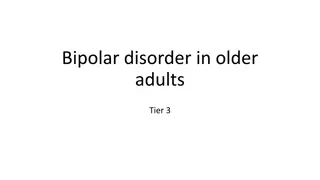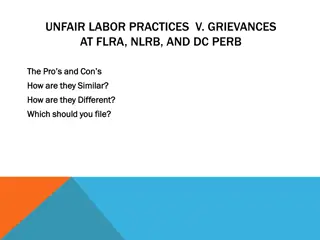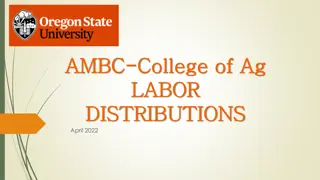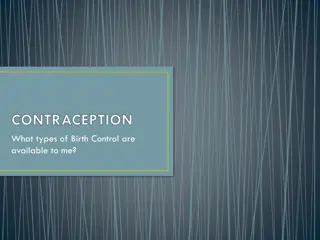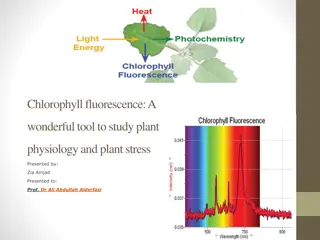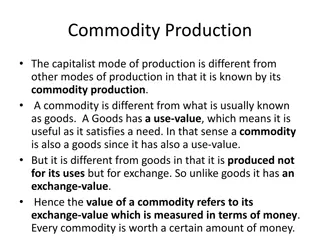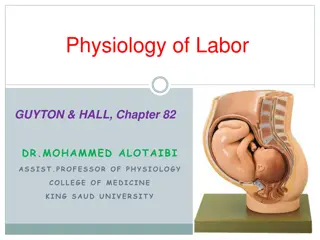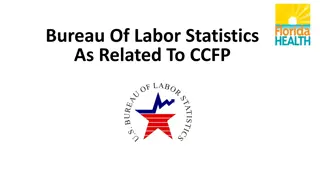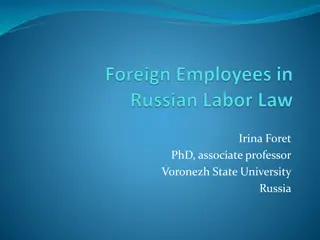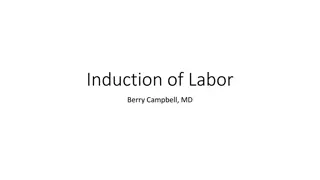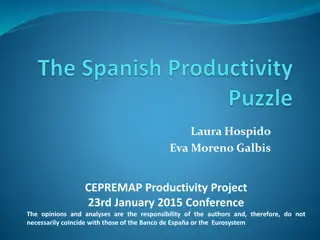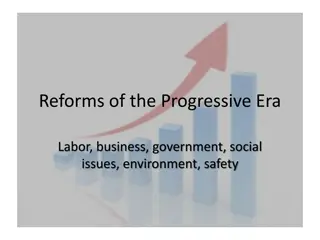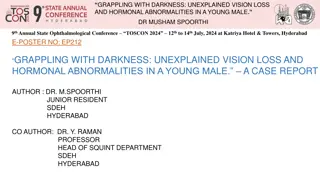Physiology of Labor: Onset and Key Hormonal Changes
Labor, or parturition, involves uterine contractions leading to the fetus's expulsion. Factors triggering labor include hormonal changes like increased estrogen and decreased progesterone, which stimulate uterine muscle activity. Telocytes play a role in spontaneous uterine activity, while oxytocin and prostaglandins contribute to contractions during labor. Understanding the phases of uterine activity and hormonal shifts is crucial in comprehending the onset and progression of labor.
Download Presentation

Please find below an Image/Link to download the presentation.
The content on the website is provided AS IS for your information and personal use only. It may not be sold, licensed, or shared on other websites without obtaining consent from the author.If you encounter any issues during the download, it is possible that the publisher has removed the file from their server.
You are allowed to download the files provided on this website for personal or commercial use, subject to the condition that they are used lawfully. All files are the property of their respective owners.
The content on the website is provided AS IS for your information and personal use only. It may not be sold, licensed, or shared on other websites without obtaining consent from the author.
E N D
Presentation Transcript
ONSET AND PHYSIOLOGY OF LABOR Dr. Hana Alzamil
Objectives: Define labor/labour (parturition). Recognize the factors triggering the onset of labor. Describe the hormonal changes that occur before and during labor. Describe the phases of uterine activity during pregnancy and labor. Know the clinical stages of labor.
Parturition Definition Uterine contractions that lead to expulsion of the fetus to extrauterine environment Towards the end of pregnancy the uterus become progressively more excitable and develops strong rhythmic contractions that lead to expulsion of the fetus.
Small group activity Does non pregnant uterus contract?
Parturition Uterus is spontaneously active. Spontaneous depolarization of pacemaker cells (Telocytes). Gap junctions spread depolarization Exact trigger is unknown Hormonal changes Mechanical changes
Hormonal changes Estrogen & Progesterone Progesterone inhibit uterine contractility Estrogen stimulate uterine contractility From 7th month till term Progesterone secretion remain constant Estrogen secretion continuously increase Increase estrogen/progesterone ratio
Hormonal changes Estrogen GAP junctions Oxytocin receptors. Prostaglandins E Progesteron GAP junctions Oxytocin receptor Prostaglandins. Resting mem. Potential P
Hormonal changes Oxytocin Dramatic of oxytocin receptors (200 folds) gradual transition from passive relaxed to active excitatory muscle ( responsiveness). Increase in Oxytocin secretion at labor Oxytocin increase uterine contractions by Directly on its receptors Indirectly by stimulating prostaglandin production
Hormonal changes Prostaglandins Central role in initiation & progression of human labour Locally produced (intrauterine) Oxytocin and cytokines stimulate its production Prostaglandin stimulate uterine contractions by: Direct effect: Through their own receptors Upregulation of myometrial gap junctions Indirect effect: Upregulation of oxytocin receptors
Mechanical changes Stretch of the uterine muscle Increases contractility Fetal movements Multiple pregnancy Stretch of the cervix Increases contractility (reflex) Membrane sweeping & rupture Fetal head Positive feedback mechanism
Initiation of Labor Baby moves deeper into mother s birth canal Figure 16.19, step 1
Initiation of Labor Baby moves deeper into mother s birth canal Pressoreceptors in cervix of uterus excited Figure 16.19, step 2
Initiation of Labor Baby moves deeper into mother s birth canal Afferent impulses to hypothalamus Pressoreceptors in cervix of uterus excited Figure 16.19, step 3
Initiation of Labor Hypothalamus sends efferent impulses to posterior pituitary, where oxytocin is stored Baby moves deeper into mother s birth canal Afferent impulses to hypothalamus Pressoreceptors in cervix of uterus excited Figure 16.19, step 4
Initiation of Labor Hypothalamus sends efferent impulses to posterior pituitary, where oxytocin is stored Posterior pituitary releases oxytocin to blood; oxytocin targets mother s uterine muscle Baby moves deeper into mother s birth canal Afferent impulses to hypothalamus Pressoreceptors in cervix of uterus excited Figure 16.19, step 5
Initiation of Labor Hypothalamus sends efferent impulses to posterior pituitary, where oxytocin is stored Posterior pituitary releases oxytocin to blood; oxytocin targets mother s uterine muscle Uterus responds by contracting more vigorously Baby moves deeper into mother s birth canal Afferent impulses to hypothalamus Pressoreceptors in cervix of uterus excited Positive feedback mechanism continues to cycle until interrupted by birth of baby Figure 16.19, step 6
Phases of parturition Phase 0 Pregnancy: uterus is relaxed (quiescent) Phase 1 Activation Phase 2 Stimulation: stage 1& stage 2 Phase 3 = stage 3 Delivery of the placenta and uterine involution
Uterine Activity During Pregnancy 21 Inhibitors Uterotrophins Estrogen Progesterone Prostaglandins CRH Uterotonins Prostaglandins Oxytocin Involution Oxytocin Progesterone Prostacycline Relaxin Nitric Oxide Parathyroid hormone-related peptide Quiescence Phase 0 Activation Phase 1 Stimulation Phase 2 Involution Phase 3
Phases of parturition Phase 0 (pregnancy) Increase in cAMP level Increase in production of Prostacyclin (PGI2) cause uterine relaxation Nitric oxide (NO) cause uterine relaxation Adapted from Smith, 2007
Phases of parturition Phase 1 (activation) Occurs in third trimester Promote a switch from quiescent to active uterus Increase excitability & responsiveness by Increase expression of gap junctions Increase G protein-coupled receptors Oxytocin receptors PGF2 alpha receptors
Phases of parturition Phase 2 (stimulation) Occurs in last 2-3 gestational weeks Increase in synthesis of uterotonins Cytokines Prostaglandins Oxytocin Includes 2 stages: Stage 1 Stage 2
Phases of parturition Phase 3 (uterine involution) Pulsatile release of oxytocin Delivery of the placenta Involution of the uterus Occurs in 4-5 weeks after delivery Lactation helps in complete involution
Mechanism of parturition Contractions start at the fundus and spreads to the lower segment The intensity of contractions is strong at the fundus but weak at the lower segment In early stages: 1 contraction/ 30 minuets As labor progress: 1 contraction/ 1-3 minutes Abdominal wall muscles contract Rhythmical contractions allows blood flow
Onset of labor During pregnancy Periodic episodes of weak and slow rhythmical uterine contractions (Braxton Hicks) 2nd trimester Towards end of pregnancy Uterine contractions become progressively stronger Suddenly uterine contractions become very strong leading to: Cervical effacement and dilatation
Stages of Labor Dilation (stage 1) Cervix becomes dilated Full dilation is 10 cm Uterine contractions begin and increase Cervix softens and effaces (thins) The amnion ruptures ( breaking the water ) Longest stage at 6-12 hours
Stages of Labor F (1 of 3)
Stages of Labor Expulsion (stage 2) Infant passes through the cervix and vagina Can last as long as 2 hours, but typically is 50 minutes in the first birth and 20 minutes in subsequent births Normal delivery is head first (vertex position) Breech presentation is buttocks-first
Stages of Labor Figure 16.20 (2 of 3)
Stages of Labor Placental stage (stage 3) Delivery of the placenta Usually accomplished within 15 minutes after birth of infant Afterbirth placenta and attached fetal membranes All placental fragments should be removed to avoid postpartum bleeding
Stages of Labor Figure 16.20 (3 of 3)
